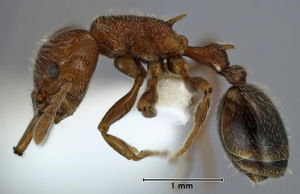Key to Epopostruma Species
The following key to Australian Epopostruma is based on Shattuck (2000), with the addition of Epopostruma inornata (Shattuck, 2007) and Epopostruma topendi (Pettit & Andersen, 2021).
1
- Sides of postpetiole expanded laterally in the form of thin spines or "wings" => 2
- Sides of postpetiole approximately vertical and rounding gradually from dorsal to posterior surfaces (although sometimes only anteriorly, the posterior corners forming spines or angles) => 3
2
- In dorsal view the lateral postpetiolar extensions forming distinct sharp teeth or spines => 4
- In dorsal view the lateral postpetiolar extensions solid and wing-like, or in one case, broadly rounded posterior angles => 5
3
- Anterior face of postpetiole relatively long and flat compared to dorsal and posterior faces => Epopostruma monstrosa
- Anterior face of postpetiole similar in length to or shorter than the dorsal and posterior faces => 6
4
- Area immediately above the eye with a small tooth => Epopostruma frosti
- Area immediately above the eye a rounded angle => 7
5
- Humeral angles of pronotum rounded, lacking spines; dorsum of petiole, postpetiole and gaster lacking erect hairs => Epopostruma curiosa
- Humeral angles of pronotum armed with spines; dorsum of petiole, postpetiole and gaster with numerous erect hairs => 8
6
- Anterior half of first gastral tergite smooth or nearly so, at most with only very weak, indistinct and generally widely spaced rugae => 9
- Anterior half of first gastral tergite (and sometimes posterior half as well) distinctly sculptured (although often sculpturing very fine), sometimes resulting in a matte appearance => 10
7
- Posterolateral margin of postpetiole (immediately anterior of gaster) flat to weakly concave => Epopostruma wardi
- Posterolateral margin of postpetiole (immediately anterior of gaster) strongly concave => Epopostruma lattini
8
- Posterior section of mesonotum forming a distinct angle with the dorsal face of propodeum so that the junction of these plates forms an obtuse angle => Epopostruma alata
- Posterior section of mesonotum in approximately the same plane as the dorsal face of propodeum so that the junction of these plates is either indistinct or in the form of a shallow trough or depression => 11
9
- In dorsal view the posterolateral teeth of the postpetiole wider than the anterolateral teeth => Epopostruma areosylva
- In dorsal view the postpetiole either lacking lateral teeth, or when present, anterolateral and posterolateral teeth approximately the same width => 12
10
- In dorsal view the posterolateral corners of postpetiole flat or rounded => Epopostruma quadrispinosa
- In dorsal view the posterolateral corners of postpetiole forming thin, angular flanges => 13
11
- Lateral margins of postpetiolar wings strongly concave => Epopostruma angela
- Lateral margins of postpetiolar wings generally flat or convex, occasionally weakly concave => 14
12
- Pronotal shoulders angular only, without spines => Epopostruma inornata
- Pronotal shoulders spinose => 12A
12A
- Dorsum of promesonotum smooth and shiny medially => Epopostruma topendi
- Dorsum of promesonotum with conspicuous foveolae throughout => 12B
12B
- In dorsal view, posterolateral corners of the postpetiole spinose, with spines longer than their basal width => Epopostruma areosylva
- In dorsal view, posterolateral corners of the postpetiole either unarmed or dentate only, with denticles only as long as their basal width => 15
13
- In full face view the lateral margin of the head between the eye and the posterior corner forming a smooth curve => Epopostruma terrula
- In full face view the lateral margin of the head between the eye and the posterior corner divided by an angle => 16
14
- Gaster distinctly bicoloured; known from New South Wales and Victoria => Epopostruma avicula
- Gaster uniform golden brown or indistinctly banded with light and dark golden brown; known from Western Australia => 17
15
- Petiolar teeth diverging slightly laterally; a row of short rugae present on the anterior margin of the gaster immediately behind the postpetiole; posterolateral corners of postpetiole with a weak angle; gaster uniform brown in colour; body colour generally brown (sometimes light brown) => Epopostruma natalae
- Petiolar teeth approximately vertical; gaster immediately behind the attachment of the gaster smooth; posterolateral corners of postpetiole drawn outwards into a short tooth; gaster yellow with a light to dark brown band; body colour dark yellow-red => Epopostruma vitta
16
- Dorsal surface of head infuscated with reddish-brown and notably darker in color than the more lightly coloured pronotum; known from New South Wales and southern Queensland => Epopostruma infuscocephala
- Dorsal surface of head uniform yellow-red and similar in colour to the pronotum; known from South Australia => 18
17
- Petiolar spines well developed, distinct; bases of the propodeal spines and lobes not connected by flanges of any sort => Epopostruma mercurii
- Petiolar spines indistinct, reduced to sharp angles; posterior face of propodeum with broad, distinct flanges which connect the bases of the spines to the propodeal lobes => Epopostruma sowestensis
18
- Petiolar spines narrow, in dorsal view their tips only slightly broader than the width of the petiole; posterior margin of head deeply concave, the angle between its sides approximately 90°; postpetiole low, its anterior face weakly separated from the dorsal face => Epopostruma angulata
- Petiolar spines diverging, in dorsal view their tips broader than the width of the petiole; posterior margin of head shallowly concave, the angle between its sides approximately 70°; postpetiole high, its anterior face separated from the dorsal face by a broad, rounded angle => Epopostruma kangarooensis
References
- Pettit, M.J., Andersen, A.N. 2021. A new species of Epopostruma (Hymenoptera: Formicidae) from monsoonal Australia. Zootaxa 5048, 141-144 (doi:10.11646/zootaxa.5048.1.9).
- Shattuck, S.O. 2000. The epopostrumiform genus group. In: Bolton, B., The ant tribe Dacetini. Memoirs of the American Entomological Institute, 65, pp. 30–67.
- Shattuck, S.O. 2007. New species of Myrmicine ants from Western Australia (Hymenoptera: Formicidae). Zootaxa 1661, 47–53.





































